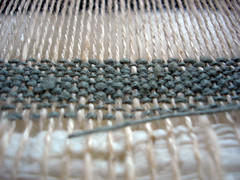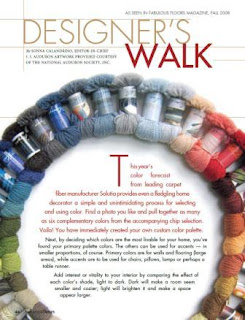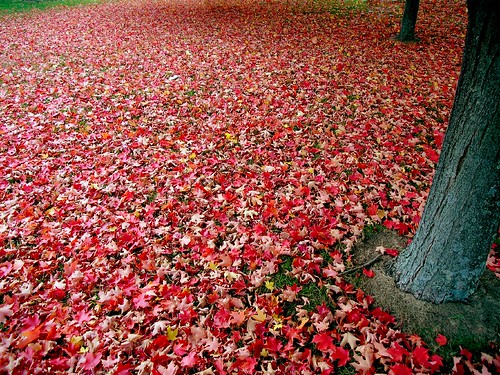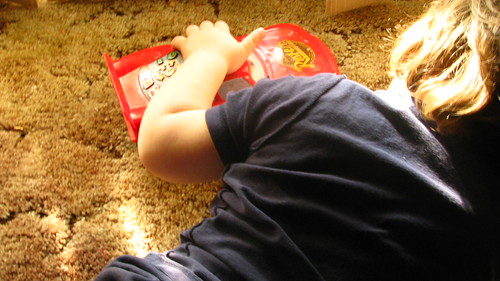 Something I struggle with across many product categories - including carpet - is evaluating quality. Think of it. How do you know that something represents high quality when many of the parameters that affect performance, durability and quality are ones that you can't readily evaluate in a store? And when lesser quality products often look comparable to those of higher quality -- even though they aren't?
Something I struggle with across many product categories - including carpet - is evaluating quality. Think of it. How do you know that something represents high quality when many of the parameters that affect performance, durability and quality are ones that you can't readily evaluate in a store? And when lesser quality products often look comparable to those of higher quality -- even though they aren't?
That's how the Wear-Dated brand and warranty came about when it was first launched in 1962 - to offer peace-of-mind to consumers and assurance that the end product [then, apparel and eventually upholstery fabrics and, now, carpet] made with our fiber would perform consistently and satisfactorily over time. Even though we are but an ingredient in the overall product, we offer an assurance of performance, of carpet quality and durability. Because we have strict carpet construction parameters to adhere to and product performance tests that carpet must pass before it can carry the Wear-Dated brand.
Okay. But, what affects quality in a carpet? Wouldn't you like to know?
If you're like me, you're paying closer attention than ever to quality. When I buy carpet, I'm looking for something that will look beautiful, be comfortable and last for a significant period of time. I'm looking for durability, for quality. Not for something quasi-disposable that I'll have to replace in a year or two. Aren't you?
I've heard horror stories about consumers having had cheap, lousy carpet pushed onto them. In a ridiculously short period of time [we are talking months rather than years], the product 'uglies' out to such an extent that the homeowner winds up ripping the carpet out and vowing never again to carpet his or her home. What a shame given the benefits that carpet offers. What a shame when better quality carpet would have completely changed that homeowner's experience...
But understandable when carpet quality seems so... fuzzy.
So, back to my question, what affects carpet quality or durability?
On the Wear-Dated website, we discuss Carpet Durability Factors and specifically refer to three factors affecting carpet durability: fiber type, density and twist.
Fiber type is the basic building block or "foundation" of carpet quality and the type of fiber will affect how well a carpet performs over time. The best carpet fiber is nylon. Nylon comes in two different 'flavors;' nylon 6,6 [vs. nylon 6] is the better of the two. Nylon and Nylon 6,6 positively affect durability and quality. Check out the
fiber comparison chart on the Wear-Dated website where we illustrate the differences between fiber types.
Next is
density which has to do with "
pile yarn spacing – or how close the tufts of yarn are spaced together – and the height of the tufts present in a square yard of carpet. Generally, the higher the density, the better the performance." This is where your hands come in handy to can
‘feel’ the density or thickness of the carpet. Imagine running your hands through grass and feeling the difference between thick, well-established sod and an un-cared for grass with bald spots and weeds and lots of poor earth showing through...
Then,
twist which relates to "
how tightly the pair of yarns in each carpet tuft is twisted. It is expressed in a #/inch of length. The tighter the twist in the yarn, the higher the number, the better the performance."
Those are the major factors. The next two are weight and pile height.
Weight tells you how much fiber is in carpet. However, it also "
is a function of the pile height and density combined" where density is the better performance measure than pile height.
[Heavier weight carpet generally costs more than lighter weight carpet. It has more fiber.]
Pile height is a matter of personal choice and preference, varying based on carpet style and practicality. It represents the distance from the carpet backing to the top of the carpet tufts.
"'Deep pile' is plusher, but can also show tracks and vacuum marks. 'Lower pile' height is firmer and may be preferred where wheeled furniture or toys are being moved around."My takeaway from all this is to first look at fiber type. Make sure you have Nylon carpet fiber. Much better is to have Nylon 6,6 carpet fiber. And, then, look for denser carpet with higher twist - particularly if you are looking for better durability. Keep in mind, though, that your ultimate carpet style choice will depend on where the carpet goes in your home...
Definitely check out the labels on the back of carpet samples. Many will capture most of this critical information.
Here we offer guidelines on how to interpret a carpet label. The Carpet & Rug Institute describes the various carpet performance ratings that you might encounter on carpet sample back labels in
Carpet Comparison Made Easy.
Also, read How Carpet is Made from the WFCA.
Do you feel a bit more comfortable appreciating carpet quality? I hope so.

Technorati Tags:
carpet quality carpet fiber type carpet fiber nylon 66 carpet fiber nylon carpet fiber carpet density carpet twist carpet durability Del.icio.us Tags:
carpet quality carpet fiber type carpet fiber nylon 66 carpet fiber nylon carpet fiber carpet density carpet twist carpet durability
 The Carpetology Blog turns one today. I'm excited beyond belief. I'm also tremendously grateful to you for making this milestone possible.
The Carpetology Blog turns one today. I'm excited beyond belief. I'm also tremendously grateful to you for making this milestone possible. 






























